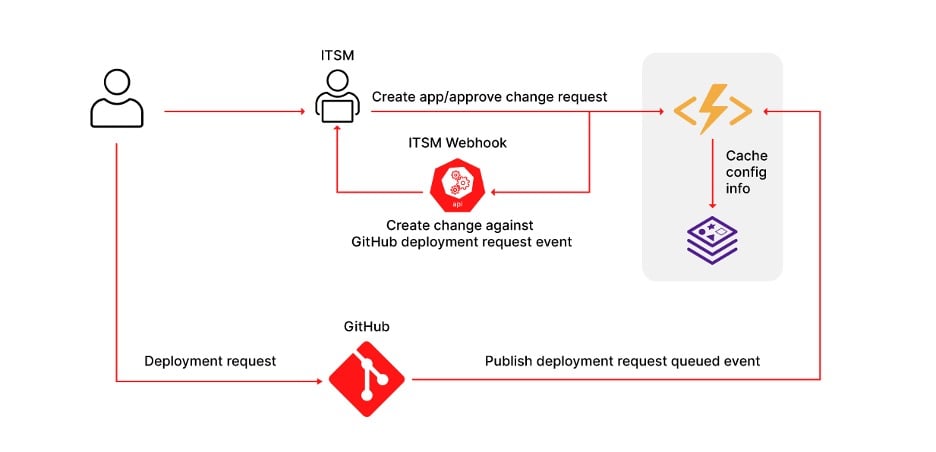How to Accelerate Deployment with an ITSM-GitHub Integration
GitHub is one of the most popular version control systems used today, allowing developers to collaborate on projects and quickly deploy their code. However, deploying code through GitHub can also be time-consuming and risky if not done properly.
In this blog, we’ll cover how IT teams can reach across the aisle to your colleagues in development to accelerate and protect their GitHub deployment by integrating with the service management software you already use.
The basics of GitHub deployment
If you work in IT, you’ve probably heard of GitHub — but unless you have a background in development, you might be less familiar with what it does.
GitHub is a popular web-based version control system for software development. It gives developers a platform to collaborate on projects, store code and deploy changes more easily. Developers can keep track of changes made to their codebase and discuss and review changes before they are integrated into the codebase.
Version control systems like GitHub are essentially a way to store all versions of a project in one place. Every time a new change is made to the project (e.g., code added or deleted), a new version is created and stored alongside the old versions so that if any issues arise due to a recent change, these can be reverted quickly without having to manually re-enter all the previous work. This makes debugging easier and helps speed up development cycles overall.
GitHub makes it easy for developers to deploy their code quickly and reliably in various environments such as production servers or staging environments without having to manually deploy every time there are updates or bug fixes needed in the app or website they are working on.
This helps save time and effort while ensuring that deployment goes smoothly with no unexpected errors appearing along the way due to manual mistakes in copying over files incorrectly or omitting certain files during deployment processes.
Why automate DevOps processes using ITSM?
GitHub deployment is a crucial part of the software development process, and automating and protecting it can make the difference between success and failure.
Automation streamlines the entire deployment process. By taking care of mundane tasks like pushing out updates or checking for bugs, automation lets you do more complex work, faster. It also eliminates the risk of human error, which can lead to costly mistakes down the line.
Automation also makes it easier to track changes over time so you can identify issues quickly and get ahead of potential problems.
Best practices in change management tools like Ivanti Neurons for ITSM can ensure that all changes are tracked and logged for improved compliance and oversight. With these tools at hand, businesses have more confidence knowing their systems are secure against malicious actors or unintended changes throughout their development cycle.
Integrating GitHub and Ivanti Neurons for ITSM
Ivanti Neurons for ITSM helps automate the deployment process through change management, which allows IT to keep track of the deployment’s history, approvals, and rejections.
In a traditional application development environment, application development would manage the release process through ITSM manually by creating a change request within ITSM. Since this is a manual process, it doesn't guarantee a change request is created whenever a deployment request is raised or the change is approved before the deployment is initiated, which may result in unauthorized or incorrect deployments.
By extending ITSM’s automated change approval process to DevOps, application development teams can work at speed, without unnecessary bottlenecks and frustrations.
The integration between GitHub and Ivanti Neurons for ITSM uses GitHub’s custom deployment protection rules and Ivanti Neurons for ITSM webhooks to automate processes.
Custom deployment protection rules are powered by GitHub Apps and run based on webhooks and callbacks. The custom apps subscribe to the deployment protection rule event, which is emitted when a deployment is triggered for a particular environment, based on which they are configured to emit certain events. These events can be forwarded to a webhook, which will integrate with Ivanti Neurons for ITSM.
Once you have created a custom deployment protection rule and installed it on your repository, the custom deployment protection rule will automatically be available for all environments in the repository.
Once a change is created within Ivanti Neurons for ITSM, it'll go through the change approval process. If the change is approved, the integration automatically notifies GitHub of the approval and changes the status of the GitHub package to allow the deployment to automatically proceed.

Unlock the potential of an ITSM and GitHub integration
Service management tools like Ivanti Neurons for ITSM can be invaluable for GitHub deployments. Automation and protection are essential for stability, reliability and efficiency, and these tools provide the features needed to ensure your deployment is secure and successful.
With Ivanti Neurons for ITSM, businesses can create a complete audit trail that records every change made to the codebase. This feature helps with debugging any errors in the code as well as pinpointing potential security vulnerabilities.
Ivanti Neurons for ITSM is designed for automating changes across multiple systems in a unified platform. It allows users to quickly identify changes needed in their system and track progress on those changes from start to finish. This reduces complexity while also ensuring that all deployments are compliant with company policies and standards before they go live.
Ivanti Neurons for ITSM can also automate your end-to-end DevSecOps process from identification and prioritization of a vulnerability, managing the vulnerability across development, operations or security teams — automatically integrating with development tools such as Jira or Azure DevOps and automating the change management process and approvals before deployment.
Using Ivanti Neurons for ITSM gives businesses more confidence in their GitHub deployment process — whether they're deploying new code directly or using specialized CI/CD pipelines by providing automation, protection and visibility into processes and reporting capabilities. Additionally, these solutions offer auditing capabilities that help maintain compliance with industry regulations such as GDPR or HIPAA.
Unlock the full potential of your service management tools like Ivanti Neurons for ITSM and take your
Unlock the full potential of your service management tools like Ivanti Neurons for ITSM and take your GitHub deployment process from good to great!

